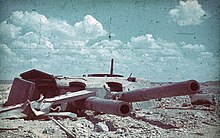Röchling shell

Röchling shells were bunker-busting artillery shells, developed by German engineer August Coenders during World War II, based on the theory of increasing the sectional density to improve penetration.[1]
Description
[edit]The subcaliber shells made from chrome-vanadium steel were able to penetrate much more than 4 metres (13 ft) of reinforced concrete roof before burying the shell through the floor and into earth.[2] They resembled fin-stabilized arrow shells, but had a discarding flange acting as a driving band instead of fins.[3] Despite high penetration, these shells had a low muzzle velocity, and thus a high dispersion, 36 m (118 ft) on 1,000 m (3,300 ft) range. As a result, they saw very limited use during World War II; only about 200 shells were ever fired even though 6,000 such shells were made for the very large howitzers like the 21 cm mortar.[citation needed]
Röchling shells were developed for the 21 cm Mörser 18, a captured French 34 cm railway gun 674(f), and the 35.5 cm Haubitze M1 only. In addition, many experimental HE shells were made for the 3.7 cm Pak 36 and 5 cm Pak 38 anti-tank guns.[4]
Use
[edit]
Röchling shells were tested in 1942 and 1943 first against the Belgian Fort de Battice then against the Belgian Fort d'Aubin-Neufchâteau.[5][6] They were also tested against the fortresses of Hůrka,[7] Hanička and Dobrošov[8][9] (today's Czech Republic),[10] the Gössler wall, Toplitzsee (Austria) and at the Hillersleben test facility (Germany).
They were regarded as a German secret weapon, and there is speculation that their use was limited in order to reduce the chance of dud shells being recovered and exploited by the Allied forces.[11] A more likely reason, however, is their poor accuracy.[12]
Preserved small-size fin-stabilized prototype of Röchling shell (36 cm long) is since 2020 exhibited in the Museum of Czechoslovakian fortifications,[13] inside the fort Hůrka. Remnants of full-sized test shells are still visible in the walls of the fort.[14]
See also
[edit]References
[edit]- ^ "Das Röchling-geschoss". Waffen Revue (in German). Vol. 72. 1988. pp. 73–106.
- ^ Georg, Friedrich (2005). Hitler's Miracle Weapons: The Secret History of the Rockets and Flying Crafts of the Third Reich Volume 2 - from the V-1 to the A-9; Unconventional Short- and Medium-Range Weapons. Helion Limited. p. 212. ISBN 9781874622628.
- ^ Basil T. Fedoroff; Henry A. Aaronson; Earl F. Reese; George D. Clift (July 7, 1958). "Röchling Anticoncrete Projectile". Dictionary of explosives, ammunition and weapons (German section). Picatinny Arsenal. p. Ger 160. doi:10.21236/ad0160636.
- ^ "Die Roechlingranaten des Heeres". www.balsi.de. Retrieved 2016-08-03.
- ^ "Premier obus flêchette". Les Canons de l'Apocalypse (in French). 30 December 2012. Retrieved 2016-08-03.
- ^ Delacruz, Jean-Paul. "Les étranges obus du fort de Neufchâteau". Reliques:souterrains et industries (in French).
- ^ "Artillery fort Hůrka – Röchling projectile embedded into the wall". Flickr. 23 August 2014. Retrieved 2016-08-03.
- ^ Čermák, Ladislav. "Bunkry.cz – Protibetonové Granáty Röchling". www.bunkry.cz. Retrieved 2016-08-03.
- ^ Čermák, Ladislav. "Bunkry.cz – Dělostřelecká tvrz Dobrošov". www.bunkry.cz. Retrieved 2016-08-03.
- ^ Jiricek, Pavel; Foglar, Marek (2015-01-01). "Numerical simulation of the effect of regular and sub-caliber projectiles on military bunkers". EPJ Web of Conferences. 94: 04049. doi:10.1051/epjconf/20159404049. ISSN 2100-014X.
- ^ Keegan, John (1990). Encyclopedia of World War II. Gallery Books. p. 212. ISBN 97-80831753504.
- ^ War and Games. "V 3 – THE HIGH-PRESSURE PUMP GUN". Archived from the original on July 23, 2009. Retrieved 2009-12-15.
- ^ Museum of Czechoslovakian fortifications (en)
- ^ Josef Ženatý (July 20, 2020). "Na tvrzi Hůrka mají světový unikát. Vojenské muzeum vystavuje prototyp tajné nacistické zbraně" [The Hůrka Fortress is a world unique. Military Museum exhibits a prototype of a secret Nazi weapon]. iROZHLAS (in Czech).
